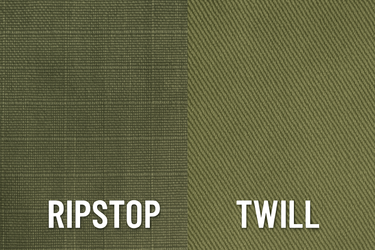The Difference Between Ripstop and Twill: What You Need to Know
Posted by Gear Up Surplus on Jul 24th 2025
The Difference Between Ripstop and Twill: What You Need to Know
When shopping for military surplus or tactical clothing, you’ll often see two common fabric terms: ripstop and twill. While they may look similar at a glance, these materials perform very differently in the field. Whether you're preparing for an outdoor mission, building a bug-out kit, or looking for durable workwear, choosing the right fabric can make all the difference in comfort, durability, and performance.
At Gear Up Surplus, we carry both ripstop and twill uniforms, pants, and gear. This guide breaks down the difference between these two fabrics so you can decide what’s best for your needs.
What Is Ripstop Fabric?
Ripstop is a woven fabric designed to resist tearing and ripping, hence the name. It’s most commonly made from a blend of nylon and cotton (NYCO) or polyester and cotton (poly-cotton) and is known for its grid-like pattern.
Key Characteristics:
- Reinforced Grid Pattern: Tiny crosshatch squares are visible up close. These thicker threads are woven at regular intervals to stop small tears from spreading.
- Lightweight Yet Strong: Despite its strength, ripstop is lightweight and breathable, making it ideal for hot weather.
- Quick Drying: The nylon or polyester components help the fabric dry faster than cotton twill.
Common Uses:
- Military combat uniforms (especially in hot weather)
- Tactical pants and jackets
- Camping tents and hammocks
- Parachutes and ponchos
Best For:
- Hot and humid climates
- Field operations or hikes where snagging is common
- Tactical training and range days
What Is Twill Fabric?
Twill is a fabric with a diagonal weave pattern, known for its durability, smooth surface, and resistance to wrinkles. It doesn’t have the grid appearance of ripstop but is still extremely durable, making it a popular choice for utility and workwear.
Key Characteristics:
- Diagonal Weave: Easily recognized by a subtle diagonal ribbing on the surface.
- Heavyweight and Tough: Usually thicker and slightly heavier than ripstop, providing better insulation and wind resistance.
- Soft Feel: Often feels smoother and more comfortable against the skin compared to ripstop.
Common Uses:
- Military dress and service uniforms
- Work pants and heavy-duty jackets
- BDU pants (Battle Dress Uniforms)
- Field gear for colder or abrasive environments
Best For:
- Cool to moderate climates
- Rugged work settings or outdoor labor
- Tactical wear where comfort and structure matter
Side-by-Side Comparison
| Feature | Ripstop | Twill |
|---|---|---|
| Weave Pattern | Crosshatch grid | Diagonal ribbing |
| Tear Resistance | High (prevents spreading) | Moderate |
| Weight | Lighter | Heavier |
| Breathability | High (ideal for hot weather) | Lower (better for cooler temps) |
| Feel | Slightly stiff or crisp | Softer and smoother |
| Drying Speed | Fast | Slower (retains more moisture) |
| Use Case | Tactical & outdoor operations | Workwear & field utility |
Which One Should You Choose?
Both fabrics are trusted by the military and outdoor professionals for good reason. The choice comes down to environment, activity, and personal preference.
- Choose Ripstop If: You’re going to be in hot, humid, or wet environments and need something lightweight, breathable, and tear-resistant.
- Choose Twill If: You’re operating in cooler climates, doing manual work, or prefer a heavier, softer uniform with more structure.
Shop Ripstop and Twill Gear at Gear Up Surplus
We stock a wide range of military surplus pants, jackets, and uniforms in both ripstop and twill, including genuine U.S. Army-issue BDU and OCP gear. Whether you're gearing up for an adventure or looking for reliable workwear, we've got what you need.
Visit us in-store or online at gearupfl.com to explore our selection of tactical apparel built for real-world performance.
